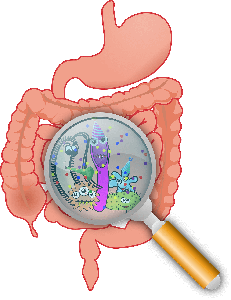In order to be broken down into macronutrients, micronutrients and molecules useful to the body, the food we eat must undergo various transformations. These are the digestive enzymes that are responsible for the evolutionary processes of the food bolus throughout its journey through the digestive lumen. Each of the primary digestive enzymes is responsible for a specific action on the different components of the food.

The circuit
The enzymatic reactions start as soon as the food enters the mouth at the first contact with the saliva. The latter contains amylase which predigests carbohydrates which include starches (cereals, seeds, potatoes, sweet potatoes, etc.). 50% of the starch is predigested at this level thanks to ptyalin. It transforms dextrin into maltose. The degradation of starches will be prolonged thanks to the pancreatic juice which contains amylase and secretions of the jejunum (central part of the small intestine).
Digestion of proteins is carried out in the stomach thanks to the mucus which secretes mucin (protects the walls of the stomach), rennet which acts on the milk, cathepsin (a typical proteolytic enzyme which digests proteins) and pepsin. The final degradation of proteins into amino acids takes place in the intestine where various enzymes (carboxypeptidases - amylopeptidases - tripeptidases - dipeptidases - enterokinases - maltases - invertins) will finish the job.
In the small intestine, there is also cellulase, which is responsible for breaking down dietary fibers, lactase, which metabolizes lactose (sugar contained in dairy products), sucrase, which manages the metabolism of most sugars or the phytase which acts on the whole of the food bowl, but which intervenes more precisely in the production of the vitamins of the B group.
As for the fatty acids (glycerols), they are separated by the pancreatic lipase. They are emulsified by the prolonged action of the pancreatic lipase which collaborates with the bile fatty acids. Divided into tiny micelles, they can then pass through the wall of the small intestine to fulfill their roles within the metabolism.
We can see that the small intestine is an essential organ since, thanks to its millions of tiny villi, it digests nearly 90% of food. These foods reduced to their basic form can finally pass through the intestinal wall. Transported by the blood towards the target organs, they are taken in charge by the metabolic enzymes to fulfill their precise function.

What happens in case of malabsorption?
From a digestive point of view, malabsorption can have 2 possible origins:
- Either it is an enzymatic deficiency: which means that the poorly degraded food cannot pass through the intestinal wall. They will therefore be evacuated through the stool without being used.
- Either the intestinal wall itself is in bad shape (porosity, clogging, candidiasis, parasitosis, unbalanced flora, etc.). If there is too much intestinal permeability, some elements will escape from the intestines before they have reached their final degradation. If there is an imbalance in the wall or the flora, the latter will no longer fulfill its role in the absorption of certain essential microelements.
Whether it is a question of bad enzymatic degradation or intestinal malabsorption, in all cases, it will be necessary to remedy the problem or risk becoming deficient or demineralized.
If there is a problem with the intestinal wall itself, the ideal is to rebuild the flora with these quality pre- and probiotics. Knowing that if there is a candidiasis or parasitosis, it will require a specific treatment for this type of problem.
As for enzymes, they are natural catalysts produced by the body. These catalysts intervene during chemical reactions to modify the reaction speed. They also accelerate the rate of return to equilibrium of the momentarily disturbed internal environment. They accompany the reactions for a given time. They are then recycled for future use. It is their protein structure that gives them their specificity of action. This structure is unfortunately very fragile. Heat, an abnormal pH or certain chemical substances (drugs, alcohol, cigarettes, etc.) denature them very easily. These changes in form make them ineffective and cause them to lose their own characteristics.
Enzymes and food
It is thus necessary to take care of its enzymatic capital. Raw and natural foods contain enzymes, which is one of the reasons why they are very digestible. This saves the body from having to make its own enzymes. Ideally, the body should be supplied with 75% of enzymes through the diet. Unfortunately, cooking (from 46°), freezing, preservation, tissue acidosis, etc., are not always the best way to prevent the development of the disease.
Whether it is digestive or metabolic enzymes, they are all very sensitive to heat and to act they require very precise pH levels. It is these very precise pH values that explain why the work of enzymes differs from one part of the digestive tract to another, each needing a specific pH to be able to act.
If we assume that there is an enzyme deficiency, we can use food supplements that contain them.
The plug of food supplement enzyme based allows 2 actions. These actions differ depending on the time of intake.
An enzyme complex taken just before or during the meal will help the digestive enzymes and will promote weight and appetite regulation.
On the other hand, if they are taken outside of meals, enzyme-based supplements will have an anti-inflammatory action.
Beware: as the omega-3The enzymes have a blood-thinning action. It is therefore not advisable to combine them with any anticoagulant medication. Ask your doctor's advice if you are taking this type of medication.



